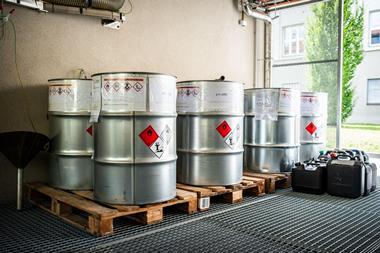There is a great deal of interest in the dissolution of cellulose in ionic liquids at the moment (Chemistry World, November 2008, p24).
It is a commonly held view that this is new science, and the use of imidazolium based ionic liquids for this purpose is certainly new.
A 1939 patent (US Patents 2179 181), however, describes the use of an amine oxide to dissolve cellulose and the subject comes up in numerous more recent patents.
A 1984 paper by Dube et al. (Journal of Polymer Science. Polymer Letters, 22, 163) discusses the dissolution of cellulose at room temperature in a mixture of N -methylmorpholine N -oxide and N,N dimethyl ethanolamine N -oxide.
Whether or not these are the first examples of dissolution of cellulose in an ionic liquid would depend on your definition of ’ionic liquid’ but amine oxides have ionic character and can (it seems) be coaxed into the liquid state.
P L Dix CChem MRSC
Ron Dell asked about rubber balls bouncing to different extents (Chemistry World, September 2008, p43). The Polysar balls he mentions were produced using polybutadiene- low loss rubber (PB), cis 1:4 polyisoprene medium loss (NR) and poly (isoprene co-isobutene) (BR) which is a high loss rubber.
When a ball hits a hard surface it will undergo distortion in the area of impact and store energy. The extent to which this distortion occurs will depend on the modulus of the material; the lower the modulus the larger the degree of distortion. So PB will deform more than NR and BR at a given temperature. The polymer molecules will have been compressed and stretched. Once the downward force has been absorbed by the impact, these molecules will attempt to recover their original state, so causing the ball to rebound. The higher energy-deformed shape of the polymer molecule will be different for different polymers, as will the rate of recovery at a given temperature. This recovery process is very hindered by the multiple methyl groups of butyl rubber, somewhat hindered by the single methyl group of the isoprene unit in natural rubber, and unhindered because of the absence of methyl groups in polybutadiene. The movement against these steric restrictions causes the absorption of energy. The resilience of a rubber is therefore a function both of the ability to store energy in deformation, and the energy lost in the deformation-recovery process. So PB is more resilient than NR than BR.
In other words changing the number of methyl groups on the chain backbone has changed the ability of the chains to store energy (PB>NR>BR), their ability to absorb energy (PB<NR<BR) and also the rate at which they recover after deformation.
R A Pethrick CChem FRSC
Glasgow, UK
A M North CChem FRSC
Bangkok, Thailand
At a recent meeting of our management team, a discussion took place among some of my colleagues involved in contaminated land investigations, regarding the consistency and reliability of chemical analysis of soil samples sent to various UKAS-accredited laboratories in the UK. It appears, from their experience, that different laboratories handle, store, prepare and assess samples with no set standard being applied, i.e. leaving samples for differing periods of time prior to analysis, extracting volatiles over differing temperature ranges, using various temperatures to dry samples and not applying standard recalibration evaluations to the analytical equipment being used for the analysis. The results of this appear to offer a degree of uncertainty, to say the least, over the accuracy and efficacy of the results obtained and reported.
As a chemist hearing these comments (most of the colleagues concerned are geologists or civil engineers), I was somewhat embarrassed and surprised that there appeared to be no recognised national or international standard method for the analysis of contaminated soils that ’accredited’ laboratories had to use.
As someone who has been involved in legal disputes regarding environmental interpretation of leachate and air emissions, it struck me that it would only be a matter of time before some smart lawyer, involved in a dispute involving land contamination, would query the whole credibility of chemical analysis if such differing results and methods of analysis were shown to be prevalent throughout the UK. This in turn could reflect badly on the credibility and professionalism of the chemists and commercial laboratories carrying out the soil sample analyses.
I would be grateful for advice regarding what sampling techniques accredited laboratories should be using for soil analysis, and what calibration standards we should be expecting commercial laboratories to demonstrate they use with regard to their analytical equipment.
J Harris MRSC,
Perth, UK
I am writing to express my concern about a recent RSC press release about science teaching which I feel was ill-informed and misguided. The press release (issued on 12 September 2008) related to the issue of dealing with creationism within school science. I write as someone who has been a member of the Society since graduation, and who is now proud to be a Fellow; and who is also very aware of the important work done by the Society to both support the teaching of chemistry and to lobby for science education.
The press release criticised another learned body, the Royal Society (RS), for ’its comments on the teaching of creationism in science lessons in UK schools’, asking ’where is science leadership in this country?’ The RSC chief executive, Richard Pike, went on to argue against teaching ’creationism as a current alternative theory’ and commented that ’it is incongruous that the Royal Society conveys the message it does’. The implication was clearly that the RS was suggesting that creationism should be taught in school science ’as a current alternative theory’.
As many readers may be aware, these comments referred to suggestions in the press that Michael Reiss, Education director of the RS, had expressed such a position. Reiss’s actual position was that creationism had no validity as a scientific theory, but that teachers faced with students offering creationist views should show respect for children’s ideas - and explain why the theory of evolution by natural selection has become the widely accepted scientific view. This follows the generally accepted approach of eliciting and challenging children’s alternative ideas about scientific topics (as for example recommended in the UK government’s National Strategy guidance). The RS itself released a statement explaining that Reiss’s comments had been misrepresented, and reaffirming that it did not support the teaching of creationist ideas in science lessons. Despite this, the unfortunate media coverage soon led to Reiss being asked to stand down from his post at the RS.
RSC officers could have readily informed Pike of the true nature of the RS position, as could the RS itself. This has certainly been an unhappy affair for science education in the UK. The RS’s actions towards Reiss appear cowardly, and seem to suggest that many FRS have little understanding of how teaching works. Sadly, the RSC’s intervention offered credence to the misinformation already in the media, and is shameful.
S Taber CChem, FRSC
Cambridge, UK
From Richard Pike, RSC chief executive
This issue has been debated over a numbers of years by the RSC council and its stance is clear and unequivocal. Creationism should not feature in school science lessons.
I was interested to note the fabric-design collaboration between Philippa Brock and crystallographer Aaron Klug (Chemistry World, November 2008, p43) and the review of Lesley Jackson’s book From atoms to patterns: crystal structure design from the 1951 Festival of Britain (Chemistry World , September 2008, p74).
I saw the original exhibition on the South Bank in 1951 and also enjoyed the 2008 retrospective exhibition at the Wellcome Foundation in London, on which the book is based.

Maryon W Dougill (who supplied a copy of the 1951 crystal-pattern exhibition booklet to the design historian Leslie Jackson) and I have both walked on a full-size woollen carpet (above) of the pentaerythritol crystal structure in the office of our then boss, E G (later Sir Gordon) Cox in the chemistry department of the University of Leeds. Dougill recalls seeing a sample of the same carpet (manufactured by Templetons, according to Jackson) exhibited in a window of Liberty in Regent Street, London, in 1951.

Incidentally, the design of one of the current official Institute of Physics ties (of which I have one), showing contours of optical vortices in wave guides, somewhat resembles the kind of design in the 1951 electron-density-map ties.
D W Jones FRSC,
Harden, Bingley, UK
Once more, we are treated to bad news from the banking and mortgage sectors. Is it by now unreasonable to conclude that the problems are not solely attributable to a few inexperienced bonus-fuelled staff but also to an appalling lack of supervision by senior management, directors and regulatory authorities?
I have spent much of my working life as a researcher in the chemical industry, much vituperated by the chattering classes. Safety to people and the environment is of paramount importance in our industry and stringent government regulations need to be met before a ’licence to sell’ is granted. All the companies for whom I have worked took pains to develop explicit policies to exceed government requirements. To meet a fundamental duty of care, they established well-resourced stewardship teams, reporting at Board level, to monitor products throughout the whole of their life-cycles.
I wonder whether the banking and mortgage sectors, and indeed the financial services industry in general, have something to learn from this approach. The culpable lack of stewardship of products, beyond receipt of commission, has been again exposed. I submit that the neglect of the duty of care shown by the financial services sector poses a greater risk to the health and well-being of the nation than the chemical industry ever has - ask anyone with a pension, mortgage or savings!
Perhaps recent events will act as a wake-up call to the benefits of manufacturing industry where tangible products can be rigourously tested and assessed, as opposed to a financial services sector which needs to guess the magnitude of its problems, and where they are buried.
David A Evans CChem FRSC,
By email












No comments yet